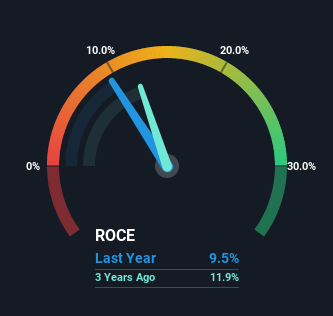Universal Health Services (NYSE:UHS) Will Want To Turn Around Its Return Trends
There are a few key trends to look for if we want to identify the next multi-bagger. One common approach is to try and find a company with returns on capital employed (ROCE) that are increasing, in conjunction with a growing amount of capital employed. Put simply, these types of businesses are compounding machines, meaning they are continually reinvesting their earnings at ever-higher rates of return. Having said that, from a first glance at Universal Health Services (NYSE:UHS) we aren't jumping out of our chairs at how returns are trending, but let's have a deeper look.
Return On Capital Employed (ROCE): What Is It?
For those that aren't sure what ROCE is, it measures the amount of pre-tax profits a company can generate from the capital employed in its business. To calculate this metric for Universal Health Services, this is the formula:
Return on Capital Employed = Earnings Before Interest and Tax (EBIT) ÷ (Total Assets - Current Liabilities)
0.095 = US$1.1b ÷ (US$13b - US$1.9b) (Based on the trailing twelve months to September 2022).
So, Universal Health Services has an ROCE of 9.5%. On its own that's a low return on capital but it's in line with the industry's average returns of 10%.
View our latest analysis for Universal Health Services
Above you can see how the current ROCE for Universal Health Services compares to its prior returns on capital, but there's only so much you can tell from the past. If you'd like, you can check out the forecasts from the analysts covering Universal Health Services here for free.
How Are Returns Trending?
On the surface, the trend of ROCE at Universal Health Services doesn't inspire confidence. Around five years ago the returns on capital were 14%, but since then they've fallen to 9.5%. However it looks like Universal Health Services might be reinvesting for long term growth because while capital employed has increased, the company's sales haven't changed much in the last 12 months. It's worth keeping an eye on the company's earnings from here on to see if these investments do end up contributing to the bottom line.
Our Take On Universal Health Services' ROCE
Bringing it all together, while we're somewhat encouraged by Universal Health Services' reinvestment in its own business, we're aware that returns are shrinking. And with the stock having returned a mere 30% in the last five years to shareholders, you could argue that they're aware of these lackluster trends. So if you're looking for a multi-bagger, the underlying trends indicate you may have better chances elsewhere.
On a final note, we've found 2 warning signs for Universal Health Services that we think you should be aware of.
While Universal Health Services may not currently earn the highest returns, we've compiled a list of companies that currently earn more than 25% return on equity. Check out this free list here.
Have feedback on this article? Concerned about the content? Get in touch with us directly. Alternatively, email editorial-team (at) simplywallst.com.
This article by Simply Wall St is general in nature. We provide commentary based on historical data and analyst forecasts only using an unbiased methodology and our articles are not intended to be financial advice. It does not constitute a recommendation to buy or sell any stock, and does not take account of your objectives, or your financial situation. We aim to bring you long-term focused analysis driven by fundamental data. Note that our analysis may not factor in the latest price-sensitive company announcements or qualitative material. Simply Wall St has no position in any stocks mentioned.
Join A Paid User Research Session
You’ll receive a US$30 Amazon Gift card for 1 hour of your time while helping us build better investing tools for the individual investors like yourself. Sign up here

